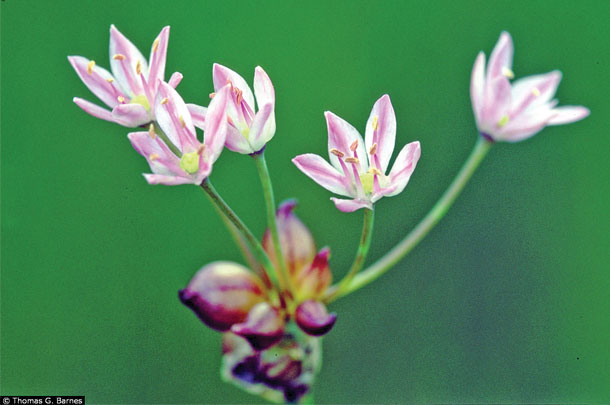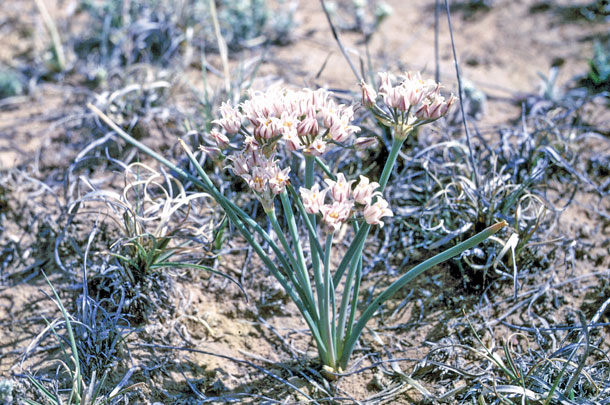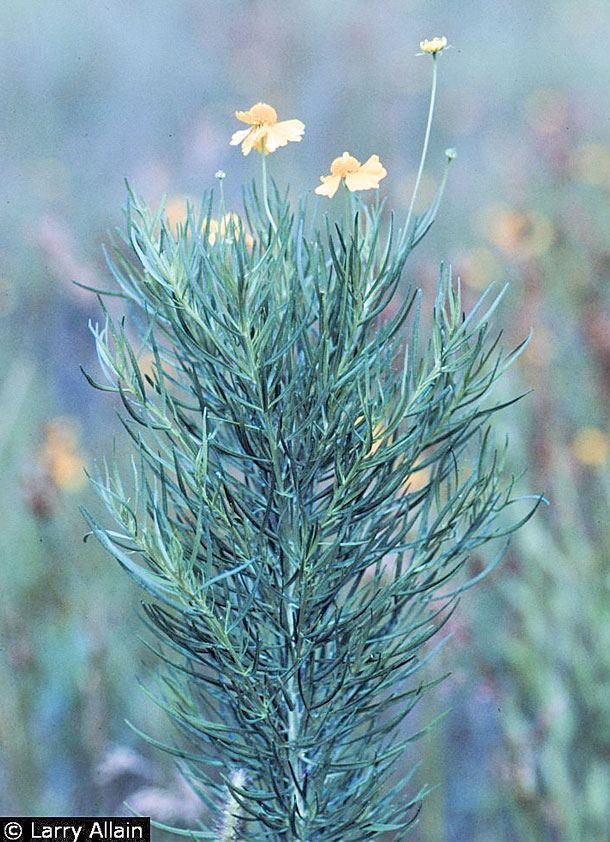Through his work, Bailey has become a very knowledgeable botanist. When asked for names of weeds that alter the flavor of milk, he immediately answered – wild onion and bitter sneezeweed. He also responded with their Latin names and where they grow.
“I haven’t received calls concerning bad tasting milk due to weeds in several years,” says Bailey. “This is probably due to the large dairies keeping their cows in dry lots or exercising good pasture management. Small dairies and people who milk a cow for their own consumption are most prone to have a problem with wild onion or bitter sneezeweed because of different management styles. Everyone, however, should remain vigilant for appearance of these two weeds, especially during drought and overgrazing situations.”
Wild onion

Wild onion is a confusing subject because there are many species in the genus that are similar in appearance. There are 14 different wild onion species in Texas alone. In reviewing documents written about wild onion, there is a wide variance in the way common names are matched with Latin or scientific names. To make it even more confusing, species of wild garlic are included in the wild onion genus.
“Wild onion (Allium drummondii) and wild garlic (Allium canadense) are two primary species that ruin the taste of milk,” says Bailey. “A good way to recognize wild onion and wild garlic is to rub a plant between your fingers. If the plant is wild onion, your fingers will smell like onion. If the plant is garlic, your fingers will smell like garlic. When these two plants are consumed by dairy cattle, their smell and taste is detectable in milk, which makes the product unsaleable.”

“The two plants are very similar in appearance and exhibit some of the same characteristics, which makes it easy to confuse one with the other. Both plants belong to the lily family (liliaceae) and are grasslike, bulb-forming perennial plants. They occur in most areas of the U.S.,” says Dr. Barron Rector, associate professor and extension range specialist, Texas A&M AgriLife Extension. Rector is recognized nationally and internationally for his plant-identification skills.
The Illinois Wild Flower database described wild onion as having a rosette of narrow basal leaves about 6 to 12 inches long. These erect, flat and often slightly arching leaves are smooth and medium green in color. Occasionally, flowering stalks emerge from the ground and are about the same height as the leaves or slightly higher. These stalks are round, stiffly erect and terminate in a flower head that produces six to 12 star-shaped flowers or a similar number of aerial bulblets.
Frequently, a combination of flowers and aerial bulblets are produced by the same plant. The flowers are white, light pink or pink and the bulblets are light green or pinkish red. There is no noticeable floral scent, but the foliage exudes a typical onion smell. The plant reproduces by its roots, seed and aerial bulblets.
In the Invasive Plant database, wild garlic is described as having round, hollow, slender stems with erect leaves. A globelike flower head composed of aerial bulblets are positioned at the top of the stems. The aerial bulblets and underground rhizomes are responsible for plant reproduction. Both species normally appear in the spring of the year where bare ground areas exist.
Rector suggests controlling wild onion and wild garlic with 2,4-D low volatile ester (LVE), Weedmaster, Grazon P+D or PastureGard. Before application, consult the product label for grazing restrictions concerning dairy cattle. Spray in late fall, late winter or early spring depending upon plant growing conditions. Two applications for two to three years may be necessary for control.
Bitter sneezeweed

“Bitter sneezeweed (Helenium amarum) is also called basin sneezeweed, rock sneezeweed and yellow dicks. It is a native annual plant, a member of the sunflower family and found in the eastern half of the U.S. and in California. The species becomes easily established in overgrazed pastures with good soil moisture,” says Rector.
As described in Plants of Texas Rangelands website, the plant reaches 10 to 20 inches tall and has narrow leaves located alternately on the stem. Its showy flowers appear in late spring or summer at the end of each branch. In some years, the plant loses its lower leaves and new growth occurs higher on the stalk and new flowers may appear in the fall.
There are two varieties of the species identical in appearance except for the flower color. One variety’s flowers are all yellow, while the other variety has yellow flowers with a red-brown center. The yellow variety prefers disturbed sandy or loamy soil and the dark-centered variety is found in calcareous soil.
Bitter sneezeweed is toxic to grazing cattle, but is rarely consumed in toxic amounts. Toxic signs in cattle are depression, weakness, diarrhea, excess salivation, incoordination, vomiting and regurgitation. When eaten, bitter sneezeweed can cause bitter, undrinkable milk and is suspected to be responsible for unpalatable meat from calves slaughtered off the pasture. The toxin is stable in plants contaminating hay; therefore, bitter sneezeweed plants in cured hay will not taint milk.
“The most economical treatment of bitter sneezeweed is to apply 1 to 2 pints of 2,4-D per acre,” says Rector. “Apply the lower rate of herbicide when the weeds are less than 6 inches tall. Treatment during this early period of growth provides better control and maximizes forage response. An amine formulation of 2,4-D is suitable for areas that receive greater than 25 inches annual rainfall. Use a low-volatile ester formulation in dryer areas. Other herbicides effective on bitter sneezeweed and certain other annual broadleaf weeds include Grazon P+D, Outlaw, Rave, Milestone, Amber, GrazonNext and Cimarron Plus.”
Proper management of pastures is a very important wild onion and bitter sneezeweed control practice. A good cover of grass shades out many weeds and doesn’t create areas of bare soil that encourages weed seed germination. Grass cover is created and maintained by proper stocking rates, rotational grazing and proper fertilization rates when needed. If herbicide applications are necessary, identify the weed and use an herbicide proven to be effective on that plant. Always read and follow the herbicide label. ![]()
PHOTO 1: Wild onion
PHOTO 2: Wild garlic
PHOTO 3: Bitter sneezeweed. Photos courtesy of NRCS Plant Database.
Robert Fears is a freelance writer based in Georgetown, Texas.









